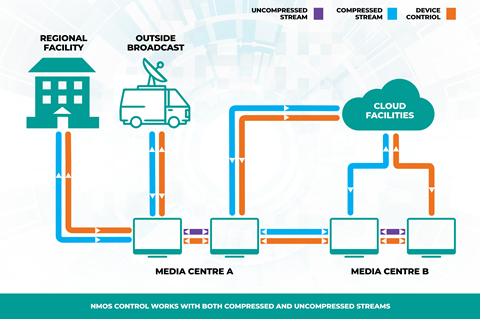Making sure there is a clearly defined set of user needs is fundamental to the start of every new phase in the ongoing AMWA NMOS project, writes David Davies.
It has – to put it mildly – been an extremely eventful decade for IP-based media. The migration from SDI and other legacy formats was, at least initially, slow and rather fragmented. But with the publication of the first standards in the SMPTE ST 2110 suite in 2017, the trend really started to achieve traction – first in broadcast, then in related markets such as pro- and enterprise AV.

But although ST 2110 provided many pieces of the IP networking puzzle, it soon became clear that there were ongoing challenges around network discovery, registration and connection management. Simply put, every component put onto a network needed to be immediately recognised and its streams easily connected to other devices. Without a clear roadmap to address these apparent ‘gaps’, there was a real danger that IP media would fail to realise its potential.
Read more IBC Accelerators 2024: Kickstart Day in review
Enter the Advanced Media Workflow Association (AMWA) and its Networked Media Open Specifications (NMOS). An initiative that both synthesises existing specifications and standards and expands upon them with additional functionality, NMOS draws on work from other well-established technology organisations including the aforementioned Society of Motion Picture and Television Engineers (SMPTE), European Broadcasting Union (EBU), Audio Engineering Society (AES) and Video Services Forum (VSF).
In recent months, NMOS has reached a decisive new phase with the realisation of the NMOS Control project, which comprises a set of specifications that will provide a full control plane solution with operational control, device configuration, monitoring and more. With a solution for operational control already published, the next piece of work – to provide device configuration – is about to get underway. The importance of this phase of development should not be understated as control is widely perceived as being one of the last major ‘obstacles’ in the media networking journey for those who wish to have a fully open architecture.
Reflecting on the evolution of NMOS over the past decade, Neil Dunstan, Director, Membership & Marketing at AMWA, stresses the underlying ethos that favours practical end-user needs above all. “No development goes ahead without a clearly defined set of user business or operational needs, supported by more than one user,” he says. “It is never a case of ‘new technology for the sake of it’.”
The roots of NMOS
It was nearly a decade ago that the first seeds of what would become NMOS started to appear. With industry developments supporting the migration from SDI intensifying, there was a meeting of VSF members in which the conversation turned to personal intentions with regard to IP.

Brad Gilmer is President of Gilmer & Associates, Executive Director of the VSF, and Executive Director of AMWA. He recalls: “There was a meeting where myself and Richard Friedel [previously with Fox Television Network Operations] stood up and without very much thought said that if everything is now moving in the direction of IP, as it seemed to be, maybe we ought to start thinking about the video and audio specifications that would allow you to do that… We knew that it wasn’t going to be a trivial matter!”
Within a year, the VSF had released two technical recommendations, TR-03 and TR-04, that would go on to constitute an important foundation for ST 2110 and NMOS. Published in October 2015, TR-03 provides for the carriage of video, audio and ancillary data as separate elementary streams that can be individually forwarded through an IP network. Issued less than a month later, TR-04 builds on TR-03 to allow complete SDI signals that have been encapsulated using ST 2022-6 to interoperate more easily with TR-03-based systems via compatible RTP time-stamping and common SDP constructs. (Read more about the specifications on the VSF website.)
“It’s vital to acknowledge that the VSF and SMPTE did some very heavy lifting on the fundamental video and audio specifications,” says Gilmer. “But at a certain point, we realised there was still a problem with [discovery and registration]. A brief explanation: in the SDI world you would take your camera and monitor and connect it to your router. Pushing a button on a router control panel would connect the camera to the monitor and you would see pictures, so that was all pretty straightforward. But when you started thinking about moving to IP, the clarity about how you found the resources on the network and then viewed them on your monitor was no longer there. You started to encounter questions such as: ‘Where is the router control panel in an IP system?’”
Read more ST 2110 and NDI: The Stellar Trajectory of IP Video
Recognising that AMWA had a “bunch of bright people who do software”, the organisation swiftly picked up the problem – ultimately emerging with the AMWA IS-04 NMOS Discovery and Registration Specification that enables control and monitoring APIs to find nodes, devices, senders, receivers, sources, flows and other resources on a network. The result is a specification that enables automation and greatly reduces the manual overhead in setting up networked systems.

“Using IS-04 meant you could have a central place where all the resources were noted and you knew that they existed, so that was a big part of the puzzle,” says Gilmer. “Then the next logical step was to develop a specification that provides a transport-independent way of connecting media nodes, which ultimately became the AMWA IS-05 NMOS Device Connection Management Specification.”
And so, in a resolutely pragmatic manner, the developmental roadmap has continued to this day. Everyone connected with NMOS is keen to stress that every new project is the result of careful consideration and the identification of what end-users require at any given time. As Gilmer confirms: “That’s always at the foundation of how we proceed.”
Tackling control and more
Whilst technical specification work inherently veers towards incremental progress, there is no doubt that the recent announcement of a full control plane solution constitutes a significant step forward. NMOS Control comprises a quartet of specifications (click the links for more detailed information): NMOS Control Architecture (MS-05-01), NMOS Control Framework (MS-05-02), NMOS Control Protocol (IS-12) and NMOS Control Feature Sets Register.
With the industry discussion having increasingly shifted from transportation to the practicalities of control and configuration, it also feels like a very timely development. “As part of our regular conversations with the user group we had discussed control at length in order to work out their priorities for control and monitoring in an IP environment, so the users have been very engaged in – and contributed significantly to – the specifications that have been developed,” says Gilmer.
Both in the user and working groups, there is an emphasis on “establishing an environment in which different views can blend together, but in which you can still keep a sense of direction and achieve good deliverables at the end of the sprint,” says Cristian Recoseanu, Development Lead at Pebble, a long-term participant in NMOS specification works, and a leading force in the development of the NMOS Control solution. “There is a big emphasis on working together to reach consensus, and actually that emerged quite quickly [with this latest project].”
Read more IBC2023 Technical Paper Sessions: Live production using 5G networks - ambitious case studies
Indeed, a hallmark of the NMOS initiative has been the willingness of industry vendors to collaborate with end-users to directly address their requirements, in preference to individual commercial considerations. Notes Gilmer: “There is a recognition that if you work together to satisfy user needs, it becomes easier to provide products that support NMOS and the overall sales potential increases.”
Present and future projects
So the inevitable question: what’s next? One area that Gilmer confirms is under consideration is some form of framework that allows NMOS and the increasingly commonplace video connectivity technology NDI to be used together. This is becoming a pressing need since a lot of facilities are now making at least some use of NDI. Meanwhile, there is always the possibility of further enhancements to NMOS’ already-extensive security specifications and best practice documents (eg. IS-10, BCP-003-01, BCP-003-02 and BCP-003-03) as the wider security environment evolves.
Work is also progressing on an open-source NMOS Receiver & Sender with fully integrated NMOS Control and Media planes. This move acknowledges the fact that, whilst the existing NMOS-CPP Repository provides a strong base for vendors to explore and develop new NMOS devices in the control plane, there is currently a dearth of full integration examples at the media and transport layers.
As a result, says Gilmer, “vendors have no choice in many cases but to develop their own integration layer from NMOS into their hardware or software. The provision of an open source example for this integration layer will allow vendors to free up resources to work on improvements and points of differentiation that generate the best added value for their customers.”
With one major NMOS-favouring vendor recently observing that they hadn’t worked on an IP project in the last 12 months without NMOS IS-04/05 being included, and a slew of major new facilities in the planning and construction stages, it seems inevitable that NMOS adoption will accelerate markedly during the next few years.
Meanwhile, the diligent work of specification development and refinement will go on, confirms Gilmer: “As has been the case throughout the history of NMOS, we will continue talking to end-users and vendors regularly about the new requirements they are seeing, and those will then feed into the next programme of work we undertake.”
Read more Protocol Progress: Market for IP innovation sees global maturation
For more information on the NMOS specifications, please visit here.
























No comments yet